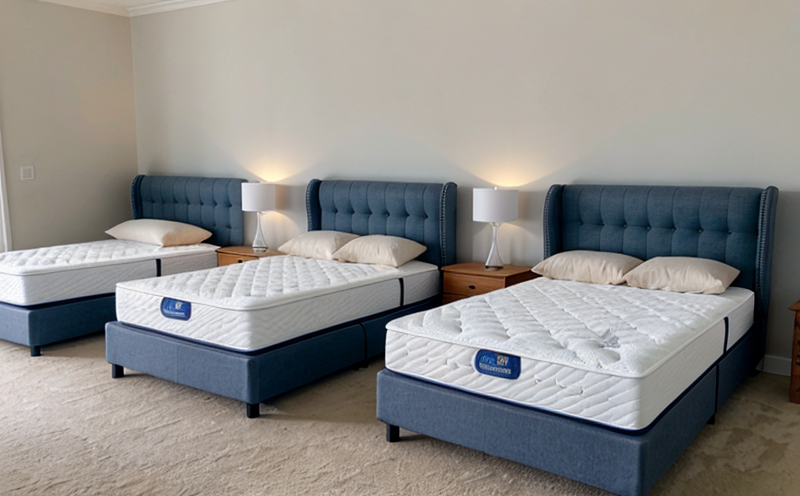ISO 7175-2 Bunk Beds Strength and Stability Testing
The ISO 7175-2 standard is a critical document that guides the testing of bunk beds, focusing on their strength and stability. This service ensures that bunk beds meet the necessary safety and durability requirements, which are essential for consumer protection and compliance with international standards.
Bunk beds are widely used in various settings including homes, schools, and dormitories, making it crucial to test them rigorously to ensure they can withstand expected loads without compromising structural integrity. The ISO 7175-2 standard is particularly important because it provides a standardized method for assessing the strength of bunk bed components such as the frame, slats, and supports.
The testing process involves several key steps: specimen preparation, loading configurations, force application, and measurement of deflection. Specimens are typically selected based on design specifications and expected use conditions. The test setup includes a rigid support structure that holds the bunk bed in place while applying loads to simulate real-world stress scenarios.
The primary focus during testing is the determination of the maximum load capacity before any structural failure occurs. This involves applying increasing weights or forces until the bunk bed exhibits signs of deformation, crack formation, or complete collapse. Deflection measurements are also taken throughout the process to evaluate how much the structure deforms under various loads.
Once the test is completed, a comprehensive report detailing all findings is generated. This report includes information about the testing methodology used, observed deformations and failures, calculated load capacities, and any recommendations for improvements if necessary. Compliance with ISO 7175-2 ensures that bunk beds meet strict quality standards ensuring user safety and satisfaction.
By adhering to this standard, manufacturers can demonstrate their commitment to producing safe, reliable products that adhere to international best practices. This not only enhances brand reputation but also helps avoid potential legal issues associated with product liability lawsuits due to defects or failures in bunk beds.
To summarize, ISO 7175-2 provides a robust framework for assessing the strength and stability of bunk beds through systematic testing procedures. It plays an indispensable role in ensuring that these products meet stringent quality benchmarks while promoting confidence among consumers about their safety and durability.
Applied Standards
The ISO 7175-2 standard specifically addresses the testing of bunk beds with regard to their strength and stability. This international specification sets out clear guidelines for conducting tests, including specimen preparation, loading configurations, force application methods, and measurement techniques.
- Test Specimen Preparation: The process begins by carefully selecting a representative sample of bunk bed units that accurately reflect the intended design and materials used in production. This ensures consistency across all tests conducted under this standard.
- Loading Configurations: Various loading scenarios are considered to simulate typical usage conditions, such as single occupancy or multiple users sharing the same sleeping area. These configurations help determine how well each bunk bed can support its intended load without experiencing structural damage.
The application of forces follows a precise protocol outlined in ISO 7175-2. For instance, when testing for vertical stability, specific weights are gradually added to different parts of the bunk bed until either deformation or failure occurs. Similarly, lateral loads may be applied to assess horizontal resistance against tipping over.
Throughout these tests, continuous monitoring is conducted using advanced instrumentation capable of accurately measuring deflections and strains in real-time. This data allows for detailed analysis of each bunk bed’s performance under stress, providing valuable insights into its overall structural integrity.
Benefits
- Enhanced Safety: By adhering to ISO 7175-2, manufacturers can significantly reduce the risk of accidents caused by structural failures or collapses. This translates into greater peace of mind for parents and educators who rely on bunk beds as essential furniture items.
- Rigorous Quality Assurance: The standardized testing procedures ensure consistent quality across all batches produced by a manufacturer. This consistency helps maintain brand reputation and customer trust in the long term.
- Avoidance of Legal Issues: Compliance with ISO 7175-2 reduces the likelihood of product liability lawsuits resulting from defective bunk beds. This legal protection can save companies substantial costs related to litigation defense and potential settlements.
Additionally, compliance with this standard allows manufacturers to participate in global markets where stringent safety regulations are enforced. Meeting these standards demonstrates a company's dedication to producing high-quality products that meet international best practices.
From an operational perspective, adherence to ISO 7175-2 streamlines the product development process by providing clear performance criteria against which new designs can be evaluated. This leads to faster time-to-market for innovative bunk bed models while ensuring they are safe and reliable right from launch.
Environmental and Sustainability Contributions
Incorporating ISO 7175-2 into the production process of bunk beds has several positive impacts on both human health and environmental sustainability. Firstly, it ensures that only durable materials are used in manufacturing, which minimizes waste generated during product lifecycle stages like disposal or recycling.
- Material Efficiency: By selecting robust materials capable of withstanding high loads without requiring frequent replacements, manufacturers contribute to reducing overall resource consumption throughout the bunk bed’s life cycle. This reduces unnecessary extraction of raw materials from natural environments.
- Eco-Friendly Manufacturing Processes: Adhering to ISO 7175-2 encourages the adoption of cleaner production practices aimed at minimizing energy use and emissions during manufacturing operations. Such initiatives support broader efforts towards greener industrial processes.
Moreover, complying with this standard fosters responsible design thinking among manufacturers who seek ways to incorporate sustainable elements into their products. For example, some companies might opt for recycled wood or other reclaimed materials when constructing bunk bed frames, further enhancing their eco-friendly credentials.
The benefits extend beyond immediate production practices; they also influence consumer behavior positively by promoting informed purchasing decisions based on recognized quality standards. Consumers who choose bunk beds that comply with ISO 7175-2 are more likely to support brands committed to sustainability and safety.





